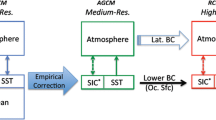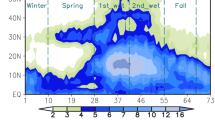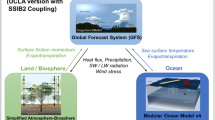Abstract
A 29-year variable resolution climate simulation is conducted from January 1988 to December 2016 using the Model for Prediction Across Scale-Atmosphere (MPAS-A), with prescribed sea surface temperatures obtained from ERA-Interim reanalysis. The global variable resolution configuration employs a mesh refinement of 92–25 km centered over East Asia. Model validations against combined observed datasets highlight that MPAS-A demonstrated advantages over three selected Regional Climate Models (RCMs) in terms of the spatial distribution of precipitation and spatial variability of the near-surface air temperature but struggled with accurately depicting temporal precipitation patterns. MPAS-A’s anomalies in mid-latitude circulation and wave activity fluxes explained the weaker cold air activities during winter in eastern China and the northward shift of the Meiyu rain belt. Common issues with reference RCMs exist in MPAS-A, such as excessive zonal moisture transport over the ocean and unrealistic interannual variability over the northwest Pacific Ocean. The wet biases over the ocean are associated with systematically higher Convective Available Potential Energy (CAPE) for MPAS-A. However, the extreme rainfall indices such as R95pTOT and R99pTOT are not completely dominated by these wet biases and still exhibit reasonable results. This finding underscores the robustness and potential of the variable resolution (VR) approach in obtaining regional information within a single model framework.
Key Points
• A global variable resolution simulation is conducted from 1988 to 2016 following CORDEX-East Asia framework.
• MPAS-A demonstrates superior spatial correlation in precipitation and better spatial variability in near-surface air temperature compared to three RCMs from CORDEX-EA-II.
• MPAS-A and RCMs exhibit similar anomalies in moisture transport, but MPAS-A performs better over the northwest Pacific Ocean.

















Similar content being viewed by others
Data availability
The released version of MPAS-A v7.0 can be downloaded from https://doi.org/10.5281/zenodo.3241875. The 92-25 km variable resolution mesh used in this study can be downloaded from http://www2.mmm.ucar.edu/projects/mpas/atmosphere_meshes/x4.163842.tar.gz The CN05.1 datasets can be obtained from http://ccrc.iap.ac.cn/resource/detailid=228. CMORPH datasets can be obtained from https://www.cpc.ncep.noaa.gov/products/janowiak/cmorph_description.html. The GPCP V3.2 could be accessed via https://measures.gesdisc.eosdis.nasa.gov/data/GPCP/GPCPMON.3.2/.
The GPCP daily precipitation v1.3 could be downloaded via https://www.ncei.noaa.gov/data/global-precipitation-climatology-project-gpcp-daily. APHRODITE V1901 and V1808 datasets could be downloaded via https://www.chikyu.ac.jp/precip/english/downloads.html. We declare that we have no conflict of interest. Interpolated monthly-averaged simulations and reference datasets are available at https://zenodo.org/record/8362716. The ERA-Interim reanalysis data (Dee et al. 2011) used for driving the MPAS-A experiments were obtained from https://www.ecmwf.int/en/forecasts/datasets/archive-datasets/reanalysis-datasets/era-interim.
References
Bukovsky MS, Gochis DJ, Mearns LO (2013) Towards assessing NARCCAP Regional Climate Model credibility for the North American Monsoon: current climate simulations. J Clim 26(22):8802–8826. https://doi.org/10.1175/JCLI-D-12-00538.1
Chen F, Dudhia J (2001) Coupling an Advanced Land surface–hydrology model with the Penn State–NCAR MM5 modeling system. Part I: model implementation and sensitivity. Mon Weather Rev 129(4):569–585. https://doi.org/10.1175/1520-0493(2001)129%3C0569:CAALSH%3E2.0.CO;2
Chen W, Wang L, Feng J, Wen Z, Ma T, Yang X, Wang C (2019) Recent progress in studies of the variabilities and mechanisms of the east Asian monsoon in a changing climate. Adv Atmos Sci 36(9):887–901. https://doi.org/10.1007/s00376-019-8230-y
Davies T (2014) Lateral boundary conditions for limited area models. Q J R Meteorol Soc 140(678):185–196. https://doi.org/10.1002/qj.2127
Davis LLB (2021) ProPlot (v0.9.5). Zenodo. https://doi.org/10.5281/zenodo.5602155
Dee DP, Uppala SM, Simmons AJ, Berrisford P, Poli P, Kobayashi S et al (2011) The ERA-Interim reanalysis: configuration and performance of the data assimilation system. Q J R Meteorol Soc 137(656):553–597. https://doi.org/10.1002/qj.828
Denis B, Côté J, Laprise R (2002) Spectral decomposition of two-Dimensional Atmospheric Fields on Limited-Area domains using the Discrete Cosine Transform (DCT). Mon Weather Rev 130(7):1812–1829. https://doi.org/10.1175/1520-0493(2002)130%3C1812:SDOTDA%3E2.0.CO;2
Feng Z, Song F, Sakaguchi K, Leung LR (2021) Evaluation of Mesoscale Convective systems in Climate simulations: Methodological Development and results from MPAS-CAM over the United States. J Clim 34(7):2611–2633. https://doi.org/10.1175/JCLI-D-20-0136.1
Fox-Rabinovitz MS, Stenchikov GL, Suarez MJ, Takacs LL (1997) A finite-difference GCM dynamical core with a variable-resolution stretched Grid. Mon Weather Rev 125(11):2943–2968. https://doi.org/10.1175/1520-0493(1997)125%3C2943:AFDGDC%3E2.0.CO;2
Fox-Rabinovitz M, Côté J, Dugas B, Déqué M, McGregor JL (2006) Variable resolution general circulation models: stretched-grid model intercomparison project (SGMIP). J Geophys Research: Atmos 111(D16). https://doi.org/10.1029/2005JD006520
Fowler LD, Skamarock WC, Grell GA, Freitas SR, Duda MG (2016) Analyzing the Grell–Freitas convection scheme from hydrostatic to nonhydrostatic scales within a global model. Monthly Weather Rev 144(6):2285–2306. https://doi.org/10.1175/MWR-D-15-0311.1
Giorgi F (2019) Thirty years of Regional Climate modeling: where are we and where are we going next? J Geophys Research: Atmos 124(11):5696–5723. https://doi.org/10.1029/2018JD030094
Giorgi F, Gutowski WJ (2015) Regional Dynamical Downscaling and the CORDEX Initiative. Annu Rev Environ Resour 40(1):467–490. https://doi.org/10.1146/annurev-environ-102014-021217
Giorgi F, Hewitson B, Arritt R, Gutowski W, Gutowski W, Knutson T, Landsea C (2001) Regional climate information—evaluation and projections
Giorgi F, Jones C, Asrar GR (2009) Addressing climate information needs at the regional level: the CORDEX framework. World Meteorological Organ (WMO) Bull 58(3):175
Guba O, Taylor MA, Ullrich PA, Overfelt JR, Levy MN (2014) The spectral element method (SEM) on variable-resolution grids: evaluating grid sensitivity and resolution-aware numerical viscosity. Geosci Model Dev 7(6):2803–2816. https://doi.org/10.5194/gmd-7-2803-2014
Hagos S, Leung R, Rauscher SA, Ringler T (2013) Error characteristics of two Grid Refinement approaches in Aquaplanet simulations: MPAS-A and WRF. Mon Weather Rev 141(9):3022–3036. https://doi.org/10.1175/MWR-D-12-00338.1
Hong S-Y (2010) A new stable boundary-layer mixing scheme and its impact on the simulated east Asian summer monsoon. Q J R Meteorol Soc 136(651):1481–1496. https://doi.org/10.1002/qj.665
Hong SY, Lim JOJ (2006) The WRF single-moment 6-class microphysics scheme (WSM6). Asia-Pac J Atmos Sci 42(2):129–151
Hong S-Y, Noh Y, Dudhia J (2006) A New Vertical Diffusion Package with an Explicit treatment of entrainment processes. Mon Weather Rev 134(9):2318–2341. https://doi.org/10.1175/MWR3199.1
Hoyer S, Hamman J (2017) Xarray: N-D labeled arrays and datasets in python. J Open Res Softw 5(1):10
Huang X, Rhoades AM, Ullrich PA, Zarzycki CM (2016) An evaluation of the variable-resolution CESM for modeling California’s climate. J Adv Model Earth Syst 8(1):345–369. https://doi.org/10.1002/2015MS000559
Huang X, Gettelman A, Skamarock WC, Lauritzen PH, Curry M, Herrington A et al (2022) Advancing precipitation prediction using a new-generation storm-resolving model framework – SIMA-MPAS (V1.0): a case study over the western United States. Geosci Model Dev 15(21):8135–8151. https://doi.org/10.5194/gmd-15-8135-2022
Hui P, Wei F, Xiao Y, Yang J, Xu J, Tang J (2022) Future projection of extreme precipitation within CORDEX East Asia phase II: multi-model ensemble. Theoret Appl Climatol 150(3):1271–1293. https://doi.org/10.1007/s00704-022-04223-0
Iacono MJ, Mlawer EJ, Clough SA, Morcrette J-J (2000) Impact of an improved longwave radiation model, RRTM, on the energy budget and thermodynamic properties of the NCAR community climate model, CCM3. J Geophys Research: Atmos 105(D11):14873–14890. https://doi.org/10.1029/2000JD900091
Iacono MJ, Delamere JS, Mlawer EJ, Shephard MW, Clough SA, Collins WD (2008) Radiative forcing by long‐lived greenhouse gases: calculations with the AER radiative transfer models. J Geophys Res: Atmos 113(D13). https://doi.org/10.1029/2008JD009944
Jiang D, Hu D, Tian Z, Lang X (2020) Differences between CMIP6 and CMIP5 models in simulating climate over China and the east Asian monsoon. Adv Atmos Sci 37(10):1102–1118. https://doi.org/10.1007/s00376-020-2034-y
Kim I-W, Oh J, Woo S, Kripalani RH (2019) Evaluation of precipitation extremes over the Asian domain: observation and modelling studies. Clim Dyn 52(3):1317–1342. https://doi.org/10.1007/s00382-018-4193-4
Kim G, Cha D-H, Park C, Jin C-S, Lee D-K, Suh M-S et al (2021) Evaluation and projection of Regional Climate over East Asia in CORDEX-East Asia Phase I experiment. Asia-Pac J Atmos Sci 57(1):119–134. https://doi.org/10.1007/s13143-020-00180-8
Klemp JB (2011) A terrain-following coordinate with smoothed coordinate surfaces. Mon Weather Rev 139(7):2163–2169. https://doi.org/10.1175/MWR-D-10-05046.1
Kramer M, Heinzeller D, Hartmann H, van den Berg W, Steeneveld G-J (2020) Assessment of MPAS variable resolution simulations in the grey-zone of convection against WRF model results and observations. Clim Dyn 55(1):253–276. https://doi.org/10.1007/s00382-018-4562-z
Liang Y, Yang B, Wang M, Tang J, Sakaguchi K, Leung LR, Xu X (2021) Multiscale simulation of precipitation over East Asia by variable resolution CAM-MPAS. J Adv Model Earth Syst 13(11):e2021MS002656
Lin J-L, Weickman KM, Kiladis GN, Mapes BE, Schubert SD, Suarez MJ et al (2008) Subseasonal Variability Associated with Asian Summer Monsoon simulated by 14 IPCC AR4 coupled GCMs. J Clim 21(18):4541–4567. https://doi.org/10.1175/2008JCLI1816.1
Logan T, Bourgault P, Smith TJ et al (2021) Ouranosinc/xclim: v0.28.1. https://doi.org/10.5281/zenodo.5146351
Lorenz P, Jacob D (2005) Influence of regional scale information on the global circulation: a two-way nesting climate simulation. Geophys Res Lett 32(18). https://doi.org/10.1029/2005GL023351
Lui YS, Tse LKS, Tam CY, Lau KH, Chen J (2021) Performance of MPAS-A and WRF in predicting and simulating western North Pacific tropical cyclone tracks and intensities. Theoret Appl Climatol 143(1–2):505–520
Michaelis AC, Lackmann GM, Robinson WA (2019) Evaluation of a unique approach to high-resolution climate modeling using the model for prediction across scales–atmosphere (MPAS-A) version 5.1. Geosci Model Dev 12(8):3725–3743. https://doi.org/10.5194/gmd-12-3725-2019
Mlawer EJ, Taubman SJ, Brown PD, Iacono MJ, Clough SA (1997) Radiative transfer for inhomogeneous atmospheres: RRTM, a validated correlated-k model for the longwave. J Geophys Research: Atmos 102(D14):16663–16682. https://doi.org/10.1029/97JD00237
Niu X, Tang J, Wang S, Fu C, Chen D (2020) On the sensitivity of seasonal and diurnal precipitation to cumulus parameterization over CORDEX-EA-II. Clim Dyn 54(1):373–393. https://doi.org/10.1007/s00382-019-05010-w
Oliger J, Sundström A (1978) Theoretical and practical aspects of some initial boundary value problems in Fluid Dynamics. SIAM J Appl Math 35(3):419–446. https://doi.org/10.1137/0135035
Qian W, Kang H-S, Lee D-K (2002) Distribution of seasonal rainfall in the east Asian monsoon region. Theoret Appl Climatol 73(3):151–168. https://doi.org/10.1007/s00704-002-0679-3
Rahimi SR, Wu C, Liu X, Brown H (2019) Exploring a variable-resolution Approach for simulating Regional Climate over the Tibetan Plateau using VR-CESM. J Geophys Research: Atmos 124(8):4490–4513. https://doi.org/10.1029/2018JD028925
Rauscher SA, Ringler TD (2014) Impact of variable-resolution meshes on Midlatitude Baroclinic eddies using CAM-MPAS-A. Mon Weather Rev 142(11):4256–4268. https://doi.org/10.1175/MWR-D-13-00366.1
Rauscher SA, Ringler TD, Skamarock WC, Mirin AA (2013) Exploring a global multiresolution modeling Approach using Aquaplanet simulations. J Clim 26(8):2432–2452. https://doi.org/10.1175/JCLI-D-12-00154.1
Ringler T, Ju L, Gunzburger M (2008) A multiresolution method for climate system modeling: application of spherical centroidal Voronoi tessellations. Ocean Dyn 58(5):475–498. https://doi.org/10.1007/s10236-008-0157-2
Ringler TD, Jacobsen D, Gunzburger M, Ju L, Duda M, Skamarock W (2011) Exploring a multiresolution modeling Approach within the shallow-water equations. Mon Weather Rev 139(11):3348–3368. https://doi.org/10.1175/MWR-D-10-05049.1
Sakaguchi K, Leung LR, Zhao C, Yang Q, Lu J, Hagos S et al (2015) Exploring a Multiresolution Approach using AMIP simulations. J Clim 28(14):5549–5574. https://doi.org/10.1175/JCLI-D-14-00729.1
Sakaguchi K, Lu J, Leung LR, Zhao C, Li Y, Hagos S (2016) Sources and pathways of the upscale effects on the Southern Hemisphere jet in MPAS-CAM4 variable-resolution simulations. J Adv Model Earth Syst 8(4):1786–1805. https://doi.org/10.1002/2016MS000743
Sillmann J, Kharin VV, Zhang X, Zwiers FW, Bronaugh D (2013) Climate extremes indices in the CMIP5 multimodel ensemble: part 1. Model evaluation in the present climate. J Geophys Research: Atmos 118(4):1716–1733. https://doi.org/10.1002/jgrd.50203
Skamarock WC, Klemp JB, Duda MG, Fowler LD, Park S-H, Ringler TD (2012) A Multiscale Nonhydrostatic Atmospheric Model using Centroidal Voronoi tesselations and C-Grid Staggering. Mon Weather Rev 140(9):3090–3105. https://doi.org/10.1175/MWR-D-11-00215.1
Sperber KR, Annamalai H, Kang I-S, Kitoh A, Moise A, Turner A et al (2013) The Asian summer monsoon: an intercomparison of CMIP5 vs. CMIP3 simulations of the late 20th century. Clim Dyn 41(9):2711–2744. https://doi.org/10.1007/s00382-012-1607-6
Takaya K, Nakamura H (2001) A formulation of a phase-independent Wave-Activity Flux for Stationary and Migratory Quasigeostrophic eddies on a Zonally varying Basic Flow. J Atmospheric Sci 58:608–627. https://doi.org/10.1175/1520-0469(2001)058%3C0608:AFOAPI%3E2.0.CO;2
Tang J, Sun X, Hui P, Li Y, Zhang Q, Liu J (2018) Effects of spectral nudging on precipitation extremes and diurnal cycle over CORDEX-East Asia domain. Int J Climatol 38(13):4903–4923. https://doi.org/10.1002/joc.5706
Tang J, Xiao Y, Hui P, Lu Y, Yu K (2022) Reanalysis-driven multi-RCM high-resolution simulation of precipitation within CORDEX East Asia Phase II. Int J Climatol 42(12):6332–6350. https://doi.org/10.1002/joc.7592
von Storch H, Langenberg H, Feser F (2000) A spectral nudging technique for Dynamical Downscaling purposes. Mon Weather Rev 128(10):3664–3673. https://doi.org/10.1175/1520-0493(2000)128%3C3664:ASNTFD%3E2.0.CO;2
Wang B, Wu R, Lau K-M (2001) Interannual variability of the Asian summer Monsoon: contrasts between the Indian and the western North Pacific–East Asian monsoons. J Clim 14(20):4073–4090. https://doi.org/10.1175/1520-0442(2001)014%3C4073:IVOTAS%3E2.0.CO;2
Wang B, Ding Q, Fu X, Kang I-S, Jin K, Shukla J, Doblas-Reyes F (2005) Fundamental challenge in simulation and prediction of summer monsoon rainfall. Geophys Res Lett 32(15). https://doi.org/10.1029/2005GL022734
Wang P, Zhang Q, Yang Y, Tang J (2019) The Sensitivity to Initial Soil Moisture for Three Severe Cases of Heat Waves Over Eastern China. Frontiers in Environmental Science, 7. Retrieved from https://www.frontiersin.org/article/https://doi.org/10.3389/fenvs.2019.00018
Warner TT, Peterson RA, Treadon RE (1997) A tutorial on lateral boundary conditions as a Basic and potentially serious limitation to Regional Numerical Weather Prediction. Bull Am Meteorol Soc 78(11):2599–2618. https://doi.org/10.1175/1520-0477(1997)078%3C2599:ATOLBC%3E2.0.CO;2
Wu J, GAO XJ (2013) A gridded daily observation dataset over China region and comparison with the other datasets. Chin J Geophys 56(4):1102–1111
Xin X, Wu T, Zhang J, Yao J, Fang Y (2020) Comparison of CMIP6 and CMIP5 simulations of precipitation in China and the east Asian summer monsoon. Int J Climatol 40(15):6423–6440. https://doi.org/10.1002/joc.6590
Xu Z, Chang A, Di Vittorio A (2022) Evaluating and projecting of climate extremes using a variable-resolution global climate model (VR-CESM). Weather Clim Extremes 38:100496. https://doi.org/10.1016/j.wace.2022.100496
Yatagai A, Kamiguchi K, Arakawa O, Hamada A, Yasutomi N, Kitoh A (2012) APHRODITE: constructing a long-term Daily Gridded Precipitation dataset for Asia based on a dense network of rain gauges. Bull Am Meteorol Soc 93(9):1401–1415. https://doi.org/10.1175/BAMS-D-11-00122.1
Yu K, Hui P, Zhou W, Tang J (2020) Evaluation of multi-RCM high‐resolution hindcast over the CORDEX East Asia Phase II region: mean, annual cycle and interannual variations. Int J Climatol 40(4):2134–2152
Zarzycki CM, Levy MN, Jablonowski C, Overfelt JR, Taylor MA, Ullrich PA (2014) Aquaplanet experiments using CAM’s variable-resolution Dynamical Core. J Clim 27(14):5481–5503. https://doi.org/10.1175/JCLI-D-14-00004.1
Zhang C, Wang Y, Hamilton K (2011) Improved Representation of Boundary Layer Clouds over the Southeast Pacific in ARW-WRF using a modified Tiedtke Cumulus Parameterization Scheme. Mon Weather Rev 139(11):3489–3513. https://doi.org/10.1175/MWR-D-10-05091.1
Zhao C, Leung LR, Park S, Hagos S, Lu J, Sakaguchi K et al (2016) Exploring the impacts of physics and resolution on aqua-planet simulations from a nonhydrostatic global variable‐resolution modeling framework. J Adv Model Earth Syst 8(4):1751–1768. https://doi.org/10.1002/2016MS000727
Zhao C, Xu M, Wang Y, Zhang M, Guo J, Hu Z et al (2019) Modeling extreme precipitation over East China with a global variable-resolution modeling framework (MPASv5.2): impacts of resolution and physics. Geosci Model Dev 12(7):2707–2726. https://doi.org/10.5194/gmd-12-2707-2019
Zhou T, Li Z (2002) Simulation of the east Asian summer monsoon using a variable resolution atmospheric GCM. Clim Dyn 19(2):167–180. https://doi.org/10.1007/s00382-001-0214-8
Zou L, Zhou T (2016) Future summer precipitation changes over CORDEX-East Asia domain downscaled by a regional ocean-atmosphere coupled model: a comparison to the stand-alone RCM. J Geophys Research: Atmos 121(6):2691–2704. https://doi.org/10.1002/2015JD024519
Zou L, Zhou T (2022) Mean and extreme precipitation changes over China under SSP scenarios: results from high-resolution dynamical downscaling for CORDEX East Asia. Clim Dyn 58(3):1015–1031. https://doi.org/10.1007/s00382-021-05947-x
Zou L, Qian Y, Zhou T, Yang B (2014) Parameter tuning and calibration of RegCM3 with MIT–Emanuel cumulus parameterization scheme over CORDEX East Asia Domain. J Clim 27:7687–7701. https://doi.org/10.1175/JCLI-D-14-00229.1
Acknowledgements
This work is jointly funded by the National Key Research and Development Program of China (grant no. 2023YFF0805404), the National Natural Science Foundation of China (U2242204, 42130602), and the Jiangsu Collaborative Innovation Center for Climate Change. The numerical calculations in this paper have been done on the computing facilities in the High Performance Computing Center (HPCC) of Nanjing University. The authors acknowledge with thanks to the ECMWF for providing the ERA-interim reanalysis data as driving fields in the simulations, NOAA for providing the GPCP data, and NOAA’s Climate Precipitation Center for providing the CMORPH observational data. We also thank Dr. Jia Wu from the National Climate Center (NCC) of China Meteorological Administration (CMA) for providing the CN05.1 gridded dataset and Dr. Akiyo YATAGAI for providing the APHRODITE dataset. The authors express gratitude towards the developers of the scientific software pivotal to this study, specifically acknowledging xarray (Hoyer and Hamman 2017), xclim (Logan et al. 2021), and proplot Luke L. B. Davis (2021).
Funding
This work is jointly funded by the National Key Research and Development Program of China (grant no. 2023YFF0805404), the National Natural Science Foundation of China (U2242204, 42130602), and the Jiangsu Collaborative Innovation Center for Climate Change.
Author information
Authors and Affiliations
Contributions
Yiyuan Cheng, Jianping Tang and Juan Fang contributed to the study conception and design. Material preparation, data collection and analysis were performed by Yiyuan Cheng, Jianping Tang and Juan Fang. Jianping Tang, Yixiong Lu, and Juan Fang helped perform the analysis with constructive discussions. Juan Fang provided financial and resource support, ensuring the smooth progression of the project. The first draft of the manuscript was written by Yiyuan Cheng and all authors commented on previous versions of the manuscript. All authors read and approved the final manuscript.
Corresponding author
Ethics declarations
Competing Interests
The authors have no conflicts of financial or non-financial interest to declare that are relevant to the content of this article.
Additional information
Publisher’s Note
Springer Nature remains neutral with regard to jurisdictional claims in published maps and institutional affiliations.
Rights and permissions
Springer Nature or its licensor (e.g. a society or other partner) holds exclusive rights to this article under a publishing agreement with the author(s) or other rightsholder(s); author self-archiving of the accepted manuscript version of this article is solely governed by the terms of such publishing agreement and applicable law.
About this article
Cite this article
Cheng, Y., Tang, J., Lu, Y. et al. Assessment of dynamical downscaling performance over cordex east Asia using MPAS-A global variable resolution model: climatology, seasonal cycle, and extreme events. Clim Dyn (2024). https://doi.org/10.1007/s00382-024-07265-4
Received:
Accepted:
Published:
DOI: https://doi.org/10.1007/s00382-024-07265-4




